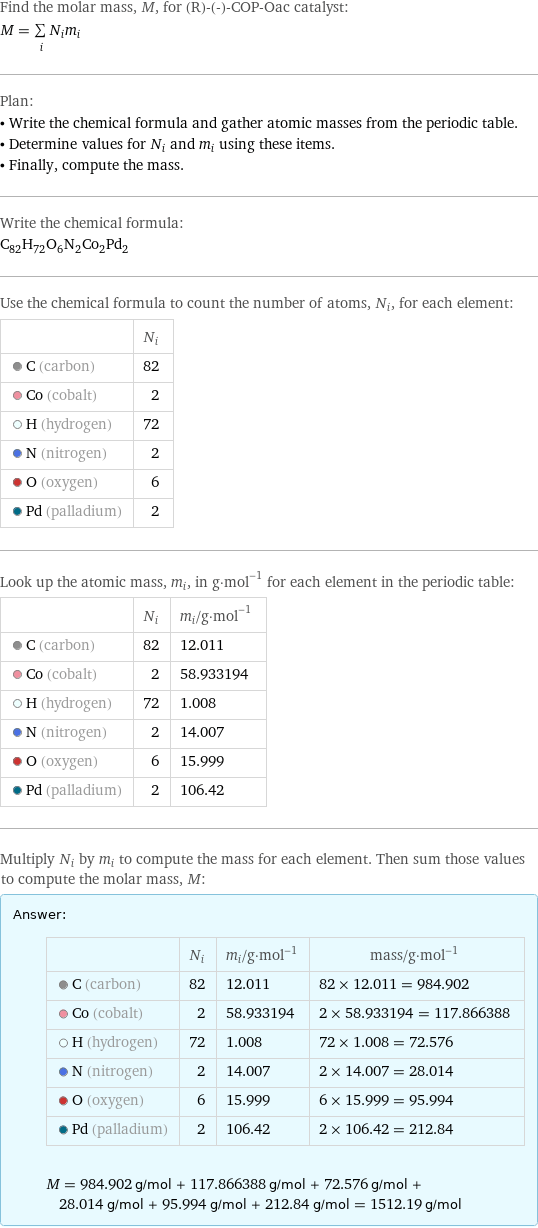Input interpretation

(R)-(-)-COP-Oac catalyst | molar mass
Result

Find the molar mass, M, for (R)-(-)-COP-Oac catalyst: M = sum _iN_im_i Plan: • Write the chemical formula and gather atomic masses from the periodic table. • Determine values for N_i and m_i using these items. • Finally, compute the mass. Write the chemical formula: C_82H_72O_6N_2Co_2Pd_2 Use the chemical formula to count the number of atoms, N_i, for each element: | N_i C (carbon) | 82 Co (cobalt) | 2 H (hydrogen) | 72 N (nitrogen) | 2 O (oxygen) | 6 Pd (palladium) | 2 Look up the atomic mass, m_i, in g·mol^(-1) for each element in the periodic table: | N_i | m_i/g·mol^(-1) C (carbon) | 82 | 12.011 Co (cobalt) | 2 | 58.933194 H (hydrogen) | 72 | 1.008 N (nitrogen) | 2 | 14.007 O (oxygen) | 6 | 15.999 Pd (palladium) | 2 | 106.42 Multiply N_i by m_i to compute the mass for each element. Then sum those values to compute the molar mass, M: Answer: | | | N_i | m_i/g·mol^(-1) | mass/g·mol^(-1) C (carbon) | 82 | 12.011 | 82 × 12.011 = 984.902 Co (cobalt) | 2 | 58.933194 | 2 × 58.933194 = 117.866388 H (hydrogen) | 72 | 1.008 | 72 × 1.008 = 72.576 N (nitrogen) | 2 | 14.007 | 2 × 14.007 = 28.014 O (oxygen) | 6 | 15.999 | 6 × 15.999 = 95.994 Pd (palladium) | 2 | 106.42 | 2 × 106.42 = 212.84 M = 984.902 g/mol + 117.866388 g/mol + 72.576 g/mol + 28.014 g/mol + 95.994 g/mol + 212.84 g/mol = 1512.19 g/mol
Unit conversion

1.5122 kg/mol (kilograms per mole)
Comparisons

≈ 2.1 × molar mass of fullerene ( ≈ 721 g/mol )

≈ 7.8 × molar mass of caffeine ( ≈ 194 g/mol )

≈ 26 × molar mass of sodium chloride ( ≈ 58 g/mol )
Corresponding quantities

Mass of a molecule m from m = M/N_A: | 2.5×10^-21 grams | 2.5×10^-24 kg (kilograms) | 1512 u (unified atomic mass units) | 1.5 kDa (kilodaltons)

Relative molecular mass M_r from M_r = M_u/M: | 1512